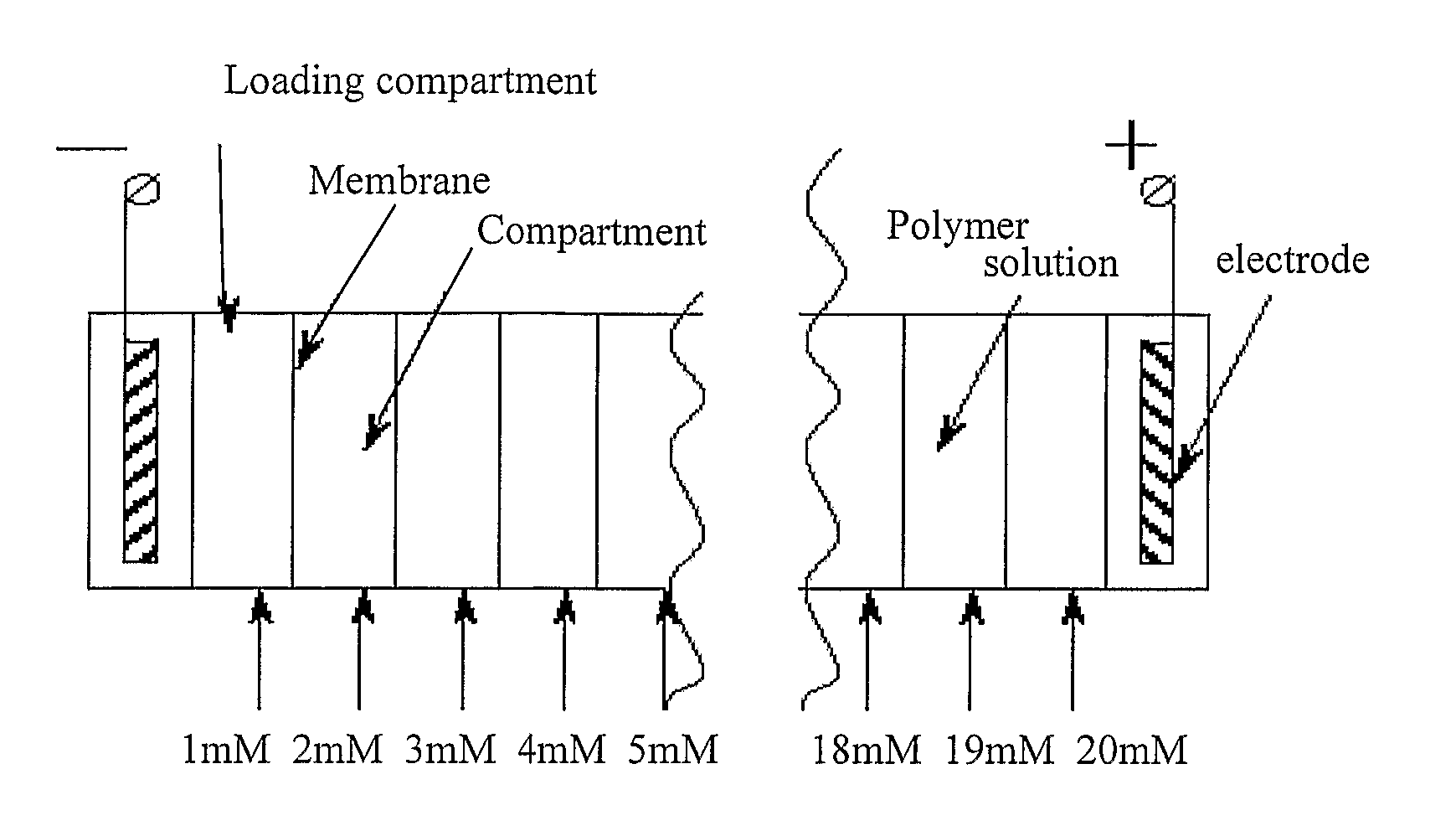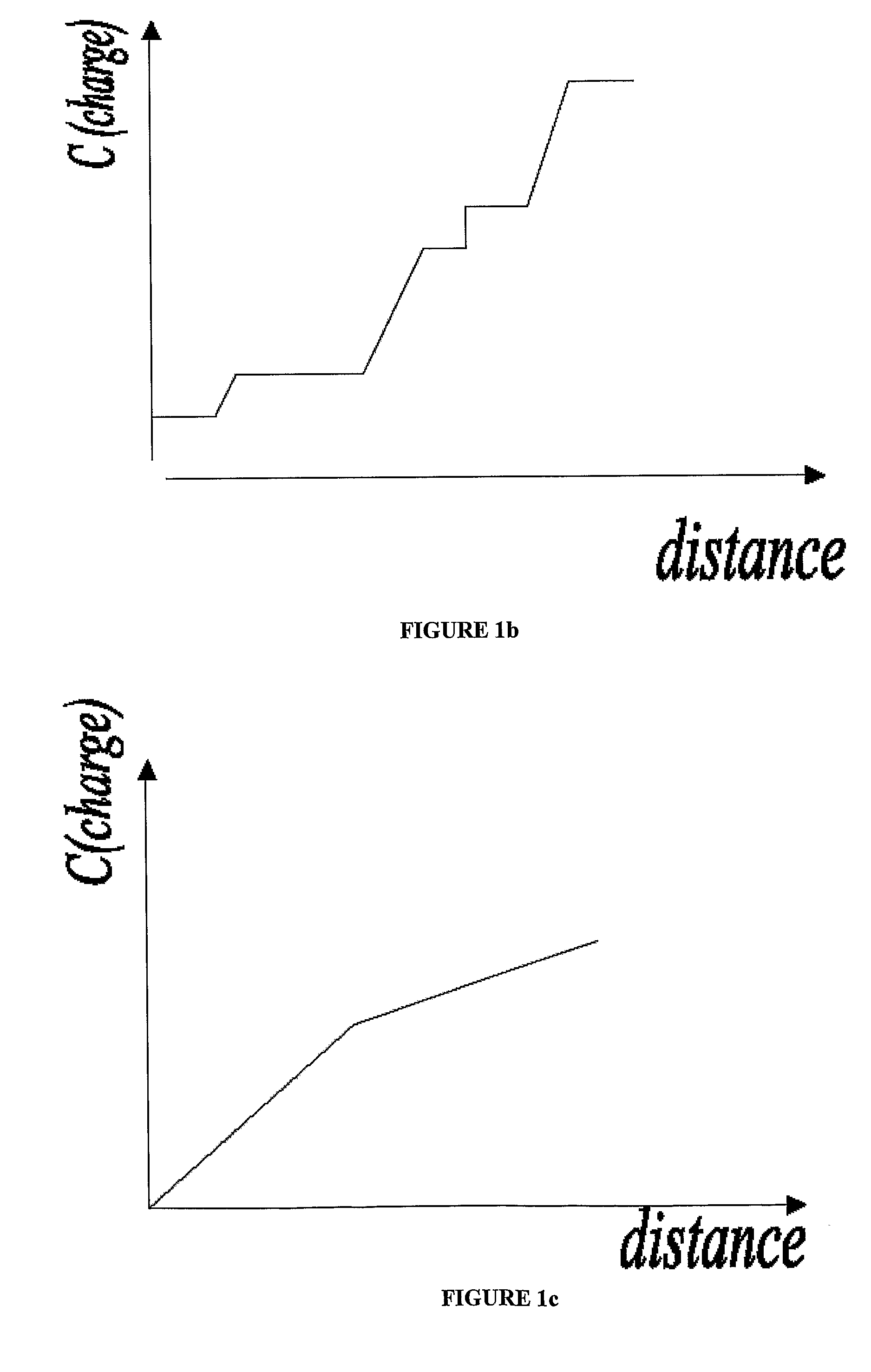Electrophoretic Separation of Analytes by Molecular Mass
a technology of molecular mass and electrophoresis, applied in the direction of electrophoresis components, material analysis by electric/magnetic means, semi-permeable membranes, etc., can solve the problems of logarithmic dependence, suffer from several drawbacks and limitations, and limit the separation of low and high-mass proteins (generally 10 kd and >200 kd), so as to achieve efficient separation of analytes
- Summary
- Abstract
- Description
- Claims
- Application Information
AI Technical Summary
Benefits of technology
Problems solved by technology
Method used
Image
Examples
example 1
Protein Separation
[0129]An 8 cm long and 0.7 cm wide charge gradient 10% polyacrylamide slab gel was prepared by stacking and polymerizing 40×2 mm high layers of polyacrylamide solution mixed with various concentrations of 9.3 pH immobiline according to Table 1. This resulted in a gel with an incorporated charge gradient starting from very low charge and charge density and ending at a high charge. The charge gradient was calculated to be linear to an appreciable degree.
[0130]After polymerization, a sample of SDS denatured colored protein mass weight markers (0.14% SDS solution incubated with 0.1% marker solution in DDW composed of alpha and beta insulin, aprotinine, lisozyme, trypsin inhibitor, carbonic anhydrase and ovalbumin) was deposited by standard methods on the slab gel and submitted to an electric field of 100V for 2 hours in a DDW buffer.
[0131]A mass separation pattern obtained by the separation method is shown in FIG. 2. As shown, a high quality separation pattern of mass ...
example 2
Separation of High Molecular Weight Proteins and Separation of a Complex Mixture
[0133]This Example demonstrates the design flexibility of the charge density gradients of the present invention. A charge gradient extending to high protein mass was designed according to Table 2, which is based on a combination of several immobilines with different pH. Based on this gradient, a slab gel of 4% polyacrylamide with dimensions of 8 cm long, 2 cm wide and 0.5 mm thickness was polymerized from 2 mm stacked layers according to the values set forth in table 2 in a sequence as presented in FIG. 4. A protein sample consisting of: insulin (4 kD), myoglobin (22 kD), Phosphorylase (148 kD) and Myosin was separated by the methods of invention. The separation time was 3 h at 150V in a DDW buffer. A mass separation pattern obtained by the separation method is provided in FIG. 5. As shown, a high quality separation pattern of a protein of with a molecular weight 250 kD was achieved.
[0134]The results dem...
example 3
Separation of Low Mass Proteins
[0137]This example demonstrates the applicability of the invention to separate proteins in the low mass range between 1-20 kD. This range is generally not achievable in standard SDS PAGE and is becoming more and more important due to the interest in low mass peptides and signaling proteins (Peptidome) and in peptides resulting from the digestion of specific proteins.
[0138]The proteins used in this example were molecular mass markers (M.W. range 2.512-16.949) (Amersham-GE, Code N 80-1129-83). The 4% PA Immobiline gradient gel used in this example was prepared with Immobiline buffer pKa 10.3 (Cat no 01741, Fluka). The following starting monomer solutions were prepared:
High concentration Immobiline solution (H-IMB)AA (acrl. + bis)1.32ml 4.0%Glycerol 86%2.3ml20.0%dist. Water2.88mlGel buffer*2.50ml 122 mM10% SDS0.100ml0.10%Immob. 10.30.900ml18.0 mMTEMED5μlTotal volume10.0ml
Low concentration Immobiline solutionAA (acrl. + bis)1.32ml4.0%Glycerol 86%0.00ml0.0%...
PUM
| Property | Measurement | Unit |
|---|---|---|
| Temperature | aaaaa | aaaaa |
| Temperature | aaaaa | aaaaa |
| Temperature | aaaaa | aaaaa |
Abstract
Description
Claims
Application Information
 Login to View More
Login to View More - R&D
- Intellectual Property
- Life Sciences
- Materials
- Tech Scout
- Unparalleled Data Quality
- Higher Quality Content
- 60% Fewer Hallucinations
Browse by: Latest US Patents, China's latest patents, Technical Efficacy Thesaurus, Application Domain, Technology Topic, Popular Technical Reports.
© 2025 PatSnap. All rights reserved.Legal|Privacy policy|Modern Slavery Act Transparency Statement|Sitemap|About US| Contact US: help@patsnap.com



